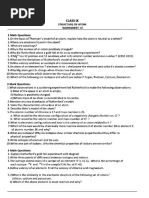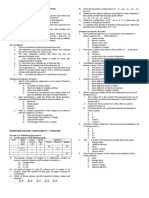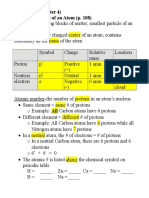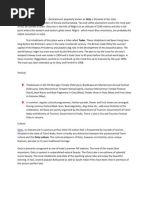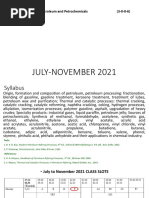chem [1]
chem [1]
Uploaded by
Sneha KumariCopyright:
Available Formats
chem [1]
chem [1]
Uploaded by
Sneha KumariCopyright
Available Formats
Share this document
Did you find this document useful?
Is this content inappropriate?
Copyright:
Available Formats
chem [1]
chem [1]
Uploaded by
Sneha KumariCopyright:
Available Formats
STRUCTURE OF THE ATOM
SHORT ANSWER QUESTIONS 2M
1. Define the following terms: a) Atomic number b) Mass number
2. Write the charges on sub atomic particles.
3. Give one Achievement and one limitation of J.J Thomson’s model of
atom?
4. What are valence electrons? Give example.
5. Which kind of elements have tendency to lose electron? Give example.
6. How many electrons are present in the valence shell of nitrogen &
Argon?
7. State the maximum capacity of various shells to accommodate electrons.
(Up to 4 shells)
8. Give the symbol, relative charge & mass of the three sub atomic articles.
9. From the symbol 3216 S state :
i) Atomic number of sulphur
ii) Mass number of sulphur
iii) Electronic configuration of sulphur.
10. Write the electronic configuration of Na+ and P3-
11. Is it possible for the atom of an element to have one electron, one
proton and no neutron. If so, name the element.
12. Write any two observations which support the fact that atoms are
divisible.
13. Why did Rutherford select a gold foil in his α–ray scattering
experiment?
14. Why do isotopes show similar chemical properties?
15. One electron is present in the outer most shell of the atom of an
element X. What would be the nature and value of charge on the ion
formed if this electron is removed from the outer most shell?
16. Write down the electron distribution of chlorine atom. How many
electrons are there in the L shell? (Atomic number of chlorine is 17).
17. In the atom of an element X, 6 electrons are present in the outermost
shell. If it acquires noble gas configuration by accepting requisite
number of electrons, then what would be the charge on the ion so
formed?
18. In response to a question, a student stated that in an atom, the number
of protons is greater than the number of neutrons, which in turn is
greater than the number of electrons. Do you agree with the statement?
Justify your answer.
19. Helium atom has 2 electrons in its valence shell but its valency is not 2,
Explain.
SHORT ANSWER QUESTIONS 3M
1. Give reasons:
a) Mass number of an atom excludes the mass of an electron.
b) Nucleus of an atom is charged.
c) Alpha particles scattering experiment was possible by using gold foil
only and not by foil of any other metal.
2. An atom of an element has 6 electrons in its ‘M’ shell.
a) Identify the element.
b) What is its atomic number?
c) State its valency.
3. a)Which of the following are isotopes and which are isobars?
Argon, Protium, Calcium and Deuterium.
b) Explain, why the isotopes have similar chemical properties but they
differ in physical properties.
4. a) Chlorine occurs in nature in two isotopic forms with masses 35u and
37u in the ratio of 3:1.Calculate the average atomic mass of Chlorine
atom on the basis of this data.
b) Write the main drawback of Rutherford’s model of an atom.
5. a) How many neutrons are present in C-14 isotope of carbon?
b) How many protons does He2+ ion possess?
c) How many electrons can be filled in the third orbit of an atom at a
maximum?
6. State the observations in α – particle scattering experiment which led
Rutherford to make the following conclusions:
a) Most of the space in an atom is empty.
b) Whole mass of an atom is concentrated at its center.
c) Center is positively charged.
7. The description of atomic particles of two elements ‘X’ and ‘Y’ is given
below.
X Y
Protons 8 8
Neutrons 8 9
Electrons 8 8
a) What is the atomic number of ‘Y’?
b) What is the mass number of ‘X’?
c) What is the relation between ‘X’ and ‘Y’?
d) Which element/elements do they represent?
e) Write the electronic configuration of ‘X’.
f) Write the cation /anion formed by the element.
You might also like
- Barbie Zelizer-About To Die - How News Images Move The Public-Oxford University Press, USA (2010) PDFDocument428 pagesBarbie Zelizer-About To Die - How News Images Move The Public-Oxford University Press, USA (2010) PDFMarcia Benetti100% (1)
- Session Plan: Learning OutcomesDocument8 pagesSession Plan: Learning OutcomesJohn James100% (2)
- worksheet chemistry Class IXDocument2 pagesworksheet chemistry Class IXlonelucca13No ratings yet
- Question Bank Blank IX ChemistryDocument4 pagesQuestion Bank Blank IX ChemistryAashna Sharma100% (1)
- Class-9-Chemistry-LESSON4-Structure-of-Atom-WORKSHEET-2Document2 pagesClass-9-Chemistry-LESSON4-Structure-of-Atom-WORKSHEET-2amitsd090No ratings yet
- 0e729488 02b4 47e5 A21d E7ca032be3d8 - Revision Sheet 2 Answer KeyDocument8 pages0e729488 02b4 47e5 A21d E7ca032be3d8 - Revision Sheet 2 Answer KeySharon BijuNo ratings yet
- StdDocument24 pagesStdaryankaith92No ratings yet
- Atomic Structure: Solved QuestionsDocument4 pagesAtomic Structure: Solved QuestionsItu Dey100% (1)
- Structure of Atom For Class 9 Solved Summative AssesmentDocument23 pagesStructure of Atom For Class 9 Solved Summative AssesmentSabu VincentNo ratings yet
- CBSE Class 9 Science Chapter 4 Structure of The Atom Important Questions 2022-23Document20 pagesCBSE Class 9 Science Chapter 4 Structure of The Atom Important Questions 2022-23Mohammed Javed KhanNo ratings yet
- Chapter 3 - 4Document5 pagesChapter 3 - 4Sureshkumar DevanNo ratings yet
- 9th Stucture of Atom Test Paper-2Document2 pages9th Stucture of Atom Test Paper-2Sabu Vincent100% (1)
- Structure of Atom Objective QuestionsDocument3 pagesStructure of Atom Objective QuestionsDivya SharmaNo ratings yet
- CH 4Document13 pagesCH 4Khushi RawatNo ratings yet
- Structure Of AtomDocument6 pagesStructure Of Atommonishak152009No ratings yet
- CBSE Class 9 Science Worksheet - Structure of AtomDocument2 pagesCBSE Class 9 Science Worksheet - Structure of AtomAjeet50% (2)
- atomic structure 9th cbseDocument1 pageatomic structure 9th cbsepavan classesNo ratings yet
- Structure Atom NewDocument7 pagesStructure Atom NewMamata JalendraNo ratings yet
- Watermark RemovedDocument11 pagesWatermark Removedjatin2008sonNo ratings yet
- class ix structure of atom testDocument1 pageclass ix structure of atom testrishabhgarg0001.rg11No ratings yet
- 9 Science Revision Worksheet(13!12!24)Document2 pages9 Science Revision Worksheet(13!12!24)makthoumsheikNo ratings yet
- Chem Assignment Class- 9 Ch-4Document4 pagesChem Assignment Class- 9 Ch-4bhartisheetal57No ratings yet
- Structure of Atom NotesDocument9 pagesStructure of Atom NotesAaryan AgrawalNo ratings yet
- Notes AdisDocument12 pagesNotes Adischarvi.bysaniNo ratings yet
- Worksheet/Atomic Model/X-1 Semester Answer The Following QuestionDocument1 pageWorksheet/Atomic Model/X-1 Semester Answer The Following QuestionRobertYueNo ratings yet
- What is the Difference Between Na and NaDocument1 pageWhat is the Difference Between Na and NataskeducareNo ratings yet
- Structure of Atom WorksheetDocument1 pageStructure of Atom WorksheetManan SharmaNo ratings yet
- Worksheet- Class 9-Chemistry- Ch-4 Structure of an atomDocument4 pagesWorksheet- Class 9-Chemistry- Ch-4 Structure of an atomtogeeta.sharmaNo ratings yet
- NCERT Exemplar Solution Class 9 Chapter 4Document14 pagesNCERT Exemplar Solution Class 9 Chapter 4Rahul N BNo ratings yet
- And Lue ISBN Test BankDocument59 pagesAnd Lue ISBN Test Bankrobert100% (37)
- 9 Cbse Structure of AtomDocument4 pages9 Cbse Structure of AtomnalinijabscreatorNo ratings yet
- 3006159-Class Ix - Chemistry - Structure of Atom - WS - Shyni VinodDocument7 pages3006159-Class Ix - Chemistry - Structure of Atom - WS - Shyni VinodDeepam kulshreshthaNo ratings yet
- Bohr's atomic model-1Document14 pagesBohr's atomic model-1amirthaaraghavan9No ratings yet
- Class 9 Science NCERT Solution Chapter 4 Structure of The AtomDocument47 pagesClass 9 Science NCERT Solution Chapter 4 Structure of The AtomArtham ResourcesNo ratings yet
- Lakhmir Singh Solutions For Class 9 Feb22 Chemistry Chapter 4 Structure of AtomDocument14 pagesLakhmir Singh Solutions For Class 9 Feb22 Chemistry Chapter 4 Structure of AtomDarshilNo ratings yet
- CHAP 4 WS STR of Atom PDF 24Document2 pagesCHAP 4 WS STR of Atom PDF 24jostna.saravananNo ratings yet
- Class 9 Science Notes Chapter 4 Structure of The AtomDocument32 pagesClass 9 Science Notes Chapter 4 Structure of The AtomArtham ResourcesNo ratings yet
- CW CH-4 - Structure of The Atom NotesDocument8 pagesCW CH-4 - Structure of The Atom NotesasdhjkhhjksdfkjhjkhjhksfdjkhjkhNo ratings yet
- Structureof the AtomDocument50 pagesStructureof the Atombasudevbhowmik5No ratings yet
- Chem Cat 1Document12 pagesChem Cat 1mongeriraphael100% (1)
- Ncert Question Answers Ch4Document12 pagesNcert Question Answers Ch4manvilohoria7429No ratings yet
- CLASS IX CH-4 ASSIGNMENT IDocument2 pagesCLASS IX CH-4 ASSIGNMENT Ilakhwinderx9989No ratings yet
- Atomic Structure: Points To RememberDocument17 pagesAtomic Structure: Points To RememberVidhi AgarwalNo ratings yet
- ICSE Class 8 Chemistry Selina Solution Chapter 4 Atomic StructureDocument8 pagesICSE Class 8 Chemistry Selina Solution Chapter 4 Atomic StructureAmmolh MahajanNo ratings yet
- 2.1.4 Notes (Chapter 4) 4.2 The Structure of An Atom (P. 108)Document9 pages2.1.4 Notes (Chapter 4) 4.2 The Structure of An Atom (P. 108)api-369706779No ratings yet
- Atomic Structure Class 9Document8 pagesAtomic Structure Class 9prayabrata2009No ratings yet
- grade 9 chapter 4 worksheetDocument2 pagesgrade 9 chapter 4 worksheetrithikasarma.789No ratings yet
- Notes Chapter 4 Structure of The Atom (23 24)Document14 pagesNotes Chapter 4 Structure of The Atom (23 24)Yu En HungNo ratings yet
- NDA class 9 0601 chemistryDocument1 pageNDA class 9 0601 chemistrySukhoi SukhoiNo ratings yet
- Structure of the AtomDocument31 pagesStructure of the Atombhargav.purushothNo ratings yet
- 5021354-Class 9 - Science - Chem - Structure of The Atom - WS With Ans. - ShyniDocument7 pages5021354-Class 9 - Science - Chem - Structure of The Atom - WS With Ans. - ShyniSantosh KumarNo ratings yet
- Structure of atomDocument1 pageStructure of atomdualgamersmitkarNo ratings yet
- Atomic_StructureDocument17 pagesAtomic_StructuresandeepNo ratings yet
- The Atom: From Philosophical Idea To Scientific Theory: Section 1Document3 pagesThe Atom: From Philosophical Idea To Scientific Theory: Section 1Marjorie NyaNo ratings yet
- 4 Structure of The Atom Multiple Choice QuestionsDocument17 pages4 Structure of The Atom Multiple Choice Questionspeacetv1031No ratings yet
- P4 Atomic Structure Combined ScienceDocument42 pagesP4 Atomic Structure Combined Sciencesamibarcelona08No ratings yet
- Quiz on chapter 2Document5 pagesQuiz on chapter 2jackeyopsNo ratings yet
- 4 Structure of Atom NotesDocument11 pages4 Structure of Atom Notestecknoanima04No ratings yet
- Instant ebooks textbook Test Bank for Biology: How Life Works Second Edition download all chaptersDocument57 pagesInstant ebooks textbook Test Bank for Biology: How Life Works Second Edition download all chaptersyobelyubar86100% (8)
- Case basedDocument16 pagesCase basedgurpreet14021988No ratings yet
- Class 9 AtomDocument1 pageClass 9 AtomDeepak SethiaNo ratings yet
- 1. LONG ANSWER TYPE (1)Document2 pages1. LONG ANSWER TYPE (1)Sneha KumariNo ratings yet
- Constitution of IndiaDocument2 pagesConstitution of IndiaSneha KumariNo ratings yet
- Why Do We Fall illDocument1 pageWhy Do We Fall illSneha KumariNo ratings yet
- ch-6 tissue notesDocument33 pagesch-6 tissue notesSneha KumariNo ratings yet
- CBSE-Grade 9-Biology-Fundamental Unit of Life- SA1Document7 pagesCBSE-Grade 9-Biology-Fundamental Unit of Life- SA1Sneha KumariNo ratings yet
- SpeechDocument1 pageSpeechKrissa Jean KingNo ratings yet
- Astm d1607 912005 Standard Test Method For Nitrogen Dioxide Content of The Atmosphere Griess Saltzman Reac 2Document9 pagesAstm d1607 912005 Standard Test Method For Nitrogen Dioxide Content of The Atmosphere Griess Saltzman Reac 2nureizzati92No ratings yet
- Beckett Football October 2020Document172 pagesBeckett Football October 2020ANTHONY PAUL REYESNo ratings yet
- History Worksheet For Intervention Classes Grade 7Document11 pagesHistory Worksheet For Intervention Classes Grade 7Bilal ImranNo ratings yet
- Traction Control DisableDocument72 pagesTraction Control DisablejohnNo ratings yet
- Jesus Bleibet Meine Freude: Jesu, Joy of Man's DesiringDocument3 pagesJesus Bleibet Meine Freude: Jesu, Joy of Man's DesiringGUSTAVO ADOLFO LARROYO SOLISNo ratings yet
- Le Morte D Arthur War Breaks Out Between Arthur and LancelotDocument6 pagesLe Morte D Arthur War Breaks Out Between Arthur and LancelotLuis Padilla NaidenovaNo ratings yet
- Turkey - Oil & Fats Profile PDFDocument3 pagesTurkey - Oil & Fats Profile PDFmrithika25012011No ratings yet
- INLAND REALTY INVESTMENT SERVICE vs. CADocument1 pageINLAND REALTY INVESTMENT SERVICE vs. CAAnonymous 8liWSgmINo ratings yet
- Grade 9 Mid - TermDocument5 pagesGrade 9 Mid - TermobedismeNo ratings yet
- How Metaphors Rule Your Life 1Document19 pagesHow Metaphors Rule Your Life 1api-202268486100% (1)
- C - , Popularly Known As Is Situated at The StateDocument2 pagesC - , Popularly Known As Is Situated at The StateJayesh RathodNo ratings yet
- Sample COMMUNITY ACTION PLAN CESCDocument5 pagesSample COMMUNITY ACTION PLAN CESCiamloui123No ratings yet
- Model - 2 Question Papers Green Computing April - May 2021Document2 pagesModel - 2 Question Papers Green Computing April - May 2021zeroxin450No ratings yet
- Solution Manual - Electronic Devices and Circuit Theory 10th EditionDocument13 pagesSolution Manual - Electronic Devices and Circuit Theory 10th EditionArsalan WaheedNo ratings yet
- Nombre:: Evaluación de La Maduración NeurolimbicaDocument16 pagesNombre:: Evaluación de La Maduración NeurolimbicaMaria Liliana RodriguezNo ratings yet
- Book by Suhana Debnath 66 PGDocument68 pagesBook by Suhana Debnath 66 PGitzsuhana08No ratings yet
- Ingles BasicoDocument34 pagesIngles BasicoErika Chahua FloresNo ratings yet
- First Year Theory ITIDocument2 pagesFirst Year Theory ITImangla prasadNo ratings yet
- Accounting Assignment#3,4Document4 pagesAccounting Assignment#3,4Humaira KhanNo ratings yet
- Merged 429 1-7Document17 pagesMerged 429 1-7shubhamNo ratings yet
- Position of The President and Prime Minister of IndiaDocument25 pagesPosition of The President and Prime Minister of IndiaubaidNo ratings yet
- Lab1 - Keil MDK - ARM and FRDM - KL46ZDocument19 pagesLab1 - Keil MDK - ARM and FRDM - KL46ZQuang HuyNo ratings yet
- Compar Ative Ad Jec Tives: Ramirez Level: Basic 03Document1 pageCompar Ative Ad Jec Tives: Ramirez Level: Basic 03Mayra Alejandra Chiquillo RamirezNo ratings yet
- RNPP Awareness (Not For Exam)Document41 pagesRNPP Awareness (Not For Exam)Amit PaulNo ratings yet
- Tripura Police Act 2007Document50 pagesTripura Police Act 2007dasaman471No ratings yet
- NAVSEA's Condition Based Maintenance Plus (CBM+) InitiativeDocument15 pagesNAVSEA's Condition Based Maintenance Plus (CBM+) InitiativefaisalNo ratings yet
- Muhammad Kafayat: Personal ProfileDocument2 pagesMuhammad Kafayat: Personal ProfileArslan AzharNo ratings yet



